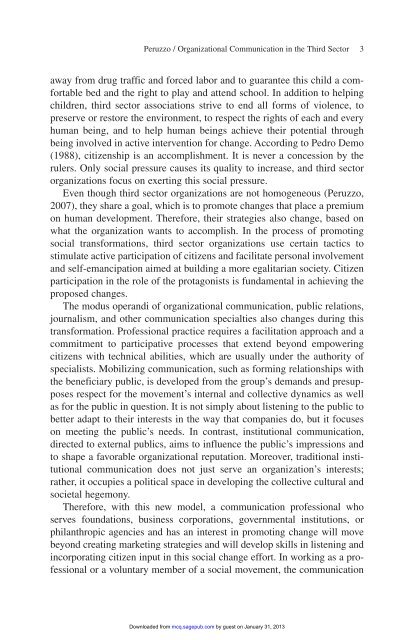Organizational Communication in the Third Sector - Management ...
Organizational Communication in the Third Sector - Management ...
Organizational Communication in the Third Sector - Management ...
You also want an ePaper? Increase the reach of your titles
YUMPU automatically turns print PDFs into web optimized ePapers that Google loves.
Peruzzo / <strong>Organizational</strong> <strong>Communication</strong> <strong>in</strong> <strong>the</strong> <strong>Third</strong> <strong>Sector</strong> 3<br />
away from drug traffic and forced labor and to guarantee this child a comfortable<br />
bed and <strong>the</strong> right to play and attend school. In addition to help<strong>in</strong>g<br />
children, third sector associations strive to end all forms of violence, to<br />
preserve or restore <strong>the</strong> environment, to respect <strong>the</strong> rights of each and every<br />
human be<strong>in</strong>g, and to help human be<strong>in</strong>gs achieve <strong>the</strong>ir potential through<br />
be<strong>in</strong>g <strong>in</strong>volved <strong>in</strong> active <strong>in</strong>tervention for change. Accord<strong>in</strong>g to Pedro Demo<br />
(1988), citizenship is an accomplishment. It is never a concession by <strong>the</strong><br />
rulers. Only social pressure causes its quality to <strong>in</strong>crease, and third sector<br />
organizations focus on exert<strong>in</strong>g this social pressure.<br />
even though third sector organizations are not homogeneous (Peruzzo,<br />
2007), <strong>the</strong>y share a goal, which is to promote changes that place a premium<br />
on human development. Therefore, <strong>the</strong>ir strategies also change, based on<br />
what <strong>the</strong> organization wants to accomplish. In <strong>the</strong> process of promot<strong>in</strong>g<br />
social transformations, third sector organizations use certa<strong>in</strong> tactics to<br />
stimulate active participation of citizens and facilitate personal <strong>in</strong>volvement<br />
and self-emancipation aimed at build<strong>in</strong>g a more egalitarian society. Citizen<br />
participation <strong>in</strong> <strong>the</strong> role of <strong>the</strong> protagonists is fundamental <strong>in</strong> achiev<strong>in</strong>g <strong>the</strong><br />
proposed changes.<br />
The modus operandi of organizational communication, public relations,<br />
journalism, and o<strong>the</strong>r communication specialties also changes dur<strong>in</strong>g this<br />
transformation. Professional practice requires a facilitation approach and a<br />
commitment to participative processes that extend beyond empower<strong>in</strong>g<br />
citizens with technical abilities, which are usually under <strong>the</strong> authority of<br />
specialists. Mobiliz<strong>in</strong>g communication, such as form<strong>in</strong>g relationships with<br />
<strong>the</strong> beneficiary public, is developed from <strong>the</strong> group’s demands and presupposes<br />
respect for <strong>the</strong> movement’s <strong>in</strong>ternal and collective dynamics as well<br />
as for <strong>the</strong> public <strong>in</strong> question. It is not simply about listen<strong>in</strong>g to <strong>the</strong> public to<br />
better adapt to <strong>the</strong>ir <strong>in</strong>terests <strong>in</strong> <strong>the</strong> way that companies do, but it focuses<br />
on meet<strong>in</strong>g <strong>the</strong> public’s needs. In contrast, <strong>in</strong>stitutional communication,<br />
directed to external publics, aims to <strong>in</strong>fluence <strong>the</strong> public’s impressions and<br />
to shape a favorable organizational reputation. Moreover, traditional <strong>in</strong>stitutional<br />
communication does not just serve an organization’s <strong>in</strong>terests;<br />
ra<strong>the</strong>r, it occupies a political space <strong>in</strong> develop<strong>in</strong>g <strong>the</strong> collective cultural and<br />
societal hegemony.<br />
Therefore, with this new model, a communication professional who<br />
serves foundations, bus<strong>in</strong>ess corporations, governmental <strong>in</strong>stitutions, or<br />
philanthropic agencies and has an <strong>in</strong>terest <strong>in</strong> promot<strong>in</strong>g change will move<br />
beyond creat<strong>in</strong>g market<strong>in</strong>g strategies and will develop skills <strong>in</strong> listen<strong>in</strong>g and<br />
<strong>in</strong>corporat<strong>in</strong>g citizen <strong>in</strong>put <strong>in</strong> this social change effort. In work<strong>in</strong>g as a professional<br />
or a voluntary member of a social movement, <strong>the</strong> communication<br />
Downloaded from<br />
mcq.sagepub.com by guest on January 31, 2013


